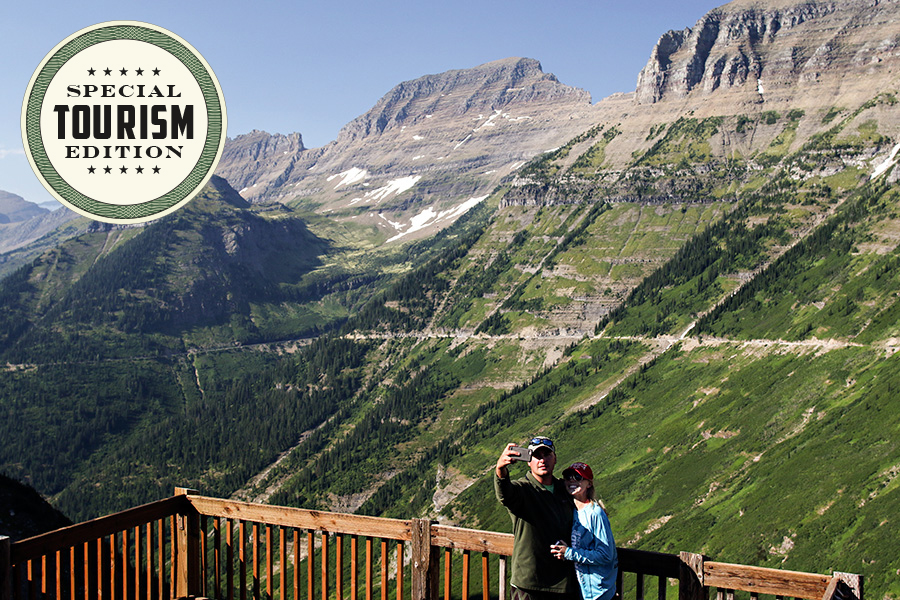Glacier at the Halfway Point: Sun, Crowds, Traffic
Good weather and spikes of attendance have the park buzzing as the National Park Service works to combat congestion
By Molly Priddy
With July nearly over and August approaching, Glacier National Park has hit summer’s halfway point, with the park poised to break more visitation records and administrators taking an active look at how best to address overcrowding issues.
June once again brought record-breaking crowds, with nearly 621,000 people visiting the park. That’s a 28 percent increase from June 2016, which held the previous visitation record for that specific month.
“We’re definitely seeing record visitation; it definitely has that feel,” said park Superintendent Jeff Mow in an interview last week. “What’s interesting about this year is the flow of visitation is not steady, so we’re seeing some real spikes. It’s got a lot of peaks and valleys.”
Mow said the inconsistencies in visitation, the ebbs and flows, make it tough for the park to understand what’s trending where. The park is working with the University of Montana to count visitors and examine where they’re heading.
_____________________
MORE FROM THIS SERIES
Montana as Tourist Magnet
Despite Influx of Vacation Rentals, Traditional Lodging Remains Strong
Finding Help in the Flathead
Glacier at the Halfway Point: Sun, Crowds, Traffic
_____________________
One peak time occurred just before the Fourth of July holiday, Mow said, when the park was buzzing. But then it really dropped off, he said.
A potential reason for the varying crowds is the Parks Canada celebration of Canada’s 150th anniversary, for which the parks are offering free admission all year. Mow said the dynamic between Waterton Lakes National Park in Canada and the Many Glacier Valley seems to be that of push and pull.
“Our initial inkling is they’re busy when we’re not, and we’re busy when they’re not,” Mow said.
But largely, the administration’s focus has been on the general crush of the summer crowds, especially along Going-to-the-Sun Road and at popular stops along the way, such as Avalanche and Logan Pass.
To help with congestion, the park opted to implement as-needed measures to close down traffic when an area is too full. For example, when the Bowman Lake parking lot is full, the park restricts traffic going up the narrow road to the lot to avoid more congestion.

“We’ve certainly found ourselves implementing some of the closures that we spoke to last winter but have never really practiced before,” Mow said. “I think we’re learning a lot in that process.”
Though the park proposed the temporary closures as responses to congestion situations, they’ve become close to standard practice in some areas.
“Originally our thinking was those were measures we would apply to very acute situations, but in some locations it’s become almost daily,” Mow said.
Part of the park’s response is getting the news out about closures through Twitter and social media as quickly as possible so people can make their travel choices, he said. For example, the park’s Twitter account noted on July 22 that day-use traffic to the Many Glacier Valley was restricted as of 1:35 p.m. for congestion, and then when that restriction was lifted at 3:30 p.m.
Mow said researchers are also tracking the efficacy of the park’s Twitter feed.
“We’re really trying to use Twitter as a tool,” he said. “Hopefully people find it useful.”
Another challenge this summer has been tracking congestion trends in Many Glacier, because there’s a bottleneck time when day-hikers haven’t gotten back to their cars yet but incoming traffic wants to use those spots, Mow said.
The park’s campgrounds have also been full. Mow said he receives notices when they fill up for the day, and those notifications have started coming earlier.
“I get the notice at sometimes 7 or 8 in the morning that the campground is full, which means there were people lining up early,” Mow said.
Other than fighting the congestion, everyone in the park (including the wildlife) is knocking on wood and crossing their fingers and toes that moisture from winter and spring holds out through the rest of summer to prevent wildfires from raging.
Mow said the moisture levels are better than they were in 2015, when blazes marred much of the park’s summer, but people should be wary.
“It’s been quite a stretch of dry weather,” Mow said. “We’ve had a little bit of precipitation, but I think definitely some of the moisture levels from last winter are carrying through. If this carries on, we expect to see an uptick (in fires) if we get the lightning.”
For the latest updates on parking and other park issues, follow the Glacier National Park Twitter feed at https://twitter.com/GlacierNPS.